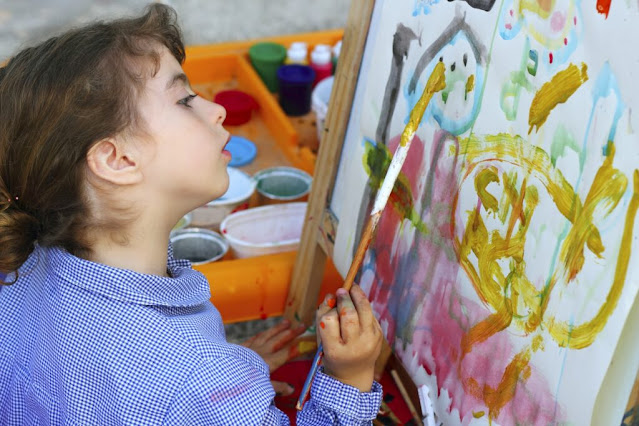Hello Friends, Today, let’s dive into the wonderful world of nurturing creativity in our kids right from the comfort of our homes. Teaching art to children is not just about creating pretty pictures; it’s about fostering imagination, boosting self-esteem, and developing problem-solving skills.
1. Why Teach Art at Home?
Before we
dive into the how-to, let’s explore why teaching art at home is so valuable.
Firstly, it allows for personalized attention tailored to your child’s
interests and abilities. Secondly, it fosters a safe and comfortable
environment where children feel free to express themselves without judgment.
And lastly, it creates cherished memories and bonding moments between you and
your little Art Maestro.
TD TD
2. Setting the Stage: Creating a Creative Space
Everymasterpiece needs a canvas, and the same goes for your child’s artisticendeavors. Dedicate a corner of your home to serve as an art studio. Stock it with a variety of art supplies like paints, brushes, crayons, markers, papers, and clay. Having easy access to materials will encourage spontaneous creativity and minimize distractions.Encourage your child to explore without worrying about making mistakes.
3. Embrace the Mess
Yes, art can
get messy, but that’s where the magic happens! Embrace the chaos and encourageyour child to explore without worrying about making mistakes. Lay down some
newspaper or a plastic tablecloth to protect surfaces, and let them dive into
their creativity without constraints.
4. Encourage Exploration and Experimentation
Art is all
about discovery. Encourage your child to explore different mediums and
techniques. From finger painting to collage-making to sculpting with clay, let
them experiment freely. Provide prompts or challenges to spark their
imagination, but also allow plenty of room for open-ended exploration. Let's
say you provide your child with a variety of art materials such as paints,
brushes, markers, colored pencils, and different types of paper. Instead of
giving them a specific prompt or project to complete, you simply invite them to
create whatever they like.
Your child
might start by experimenting with mixing colors on a blank canvas, then decide
to incorporate collage elements by tearing up pieces of paper and gluing them
down. As they work, they might spontaneously come up with new ideas, change
their approach, or combine different techniques.
By allowing
your child the freedom to explore and create without limitations, you're
nurturing their imagination, building their confidence, and fostering a
lifelong love for art. Open-ended exploration empowers children to trust their
instincts, take risks, and embrace the creative process in all its beautiful
unpredictability.
Art is not
just about creating something beautiful; it’s about problem-solving and
critical thinking. Encourage your child to think outside the box by asking
open-ended questions like “What else could this be?” or “How can you make it
more colorful?” Encourage them to find creative solutions to artistic
challenges, fostering resilience and adaptability along the way.
6. Incorporate Art into Daily Life
Art doesn’t
have to be confined to the studio. Look for opportunities to incorporate it
into your daily routine. Whether it’s doodling in a sketchbook while waiting ata restaurant or creating homemade cards for special occasions, find ways to weave art into your child’s everyday life. This not only reinforces their
skills but also instills a lifelong love for creativity.
7. Lead by Example
Children
learn by example, so don’t be afraid to get your hands dirty and join in the
artistic fun! Show them that art is not just for kids but for everyone. Create
alongside them, share your own creative process, and celebrate each other’s
creations. This not only strengthens your bond but also shows them that
creativity knows no age limit.
TD TD
8. Provide Positive Feedback
As your childcreates, be sure to provide plenty of positive feedback and encouragement.Focus on the effort rather than the end result, praising their creativity,imagination, and persistence. Encourage them to reflect on their work, asking
questions like “What do you like best about your creation?” or “What would you
do differently next time?” This helps build their confidence and
self-awareness.
9. Explore Artistic Resources
Thanks to the wonders of technology, there are countless resources available to support your child’s artistic journey. From online tutorials to virtual museum tours to art-themed apps, take advantage of these resources to inspire and educate your little artist. And don’t forget about good old-fashioned books! Visit your local library or bookstore and explore the vast array of children’s books on art and creativity.For more insights on nurturing creativity and preserving these precious memories, check out our blog post on ‘10 Engaging Art Reflection Questions to Inspire Creativity in Kids.’"
10. Celebrate Creativity
Finally,
don’t forget to celebrate your child’s creativity every step of the way.
Display their artwork proudly around the house, create a gallery wall where
they can showcase their masterpieces, or host a mini art exhibit for family and
friends. Celebrating their creativity not only boosts their self-esteem but
also reinforces the value of art in their lives.
TD TD
Friends, Teaching
art to kids at home is not just about creating pretty pictures; it’s about
nurturing creativity, fostering self-expression, and instilling a lifelong love
for the arts. By creating a supportive environment, encouraging exploration and
experimentation, leading by example, and celebrating their achievements, you
can help unlock your child’s creative potential and set them on a path to
artistic greatness. So, what are you waiting for? Let’s get creative!
I hope you
found these tips helpful in unleashing your child’s inner creativity. Remember,
the journey is just as important as the destination, so enjoy every colorful
moment along the way!
Until next
time, happy creating!
TDTD





Comments
Post a Comment